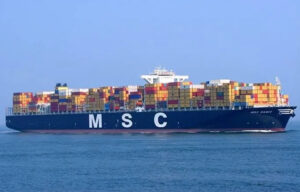

In the context of the progress of new crown vaccination and the increasingly active economic activities in developed countries, logistics congestion is becoming more and more serious. The Nihon Keizai Shimbun said on June 3 that in the United States, the indicator showing the delay in the arrival of manufacturing orders in May refreshed its high level since the 1970s. The report believes that if the situation where supply cannot keep up with the surge in demand continues, it will greatly increase inflationary pressure and hinder the recovery of the global economy from the epidemic. At the same time, crude oil prices continue to rise and the recent rising international food prices are warnings of global commodity inflation risks.
Poor shipping and rising freight rates
“Container chaos attacked European ports.” According to a report in the German “Business Daily” on the 6th, two months after the Suez Canal accident, delays in European ports are still very serious. Moreover, the index value of the container freight rate is still rising. On the Shanghai-Rotterdam route, the 40-foot container rate was US$7,937 on March 11, and has risen to US$10,174 by the end of May. In many cases, the actual freight rate is higher. The price shown in the index.
According to the Nihon Keizai Shimbun, container freight from Shanghai to the west coast of the United States is regarded as an indicator of international ocean freight, and as of late May, it has more than doubled from a year ago. Mr. Hashimoto, President of Japanese Merchant Marine Mitsui, said, “Although the congestion situation is improving, the flow of goods is increasing due to the global economic recovery and the fiscal stimulus policies of various countries. It may take longer than expected for freight rates to return to normal levels.”
In the Port of Long Beach, Los Angeles, one of the world’s major ports, more than 20 ships, including large container ships that were unable to enter the port due to “congestion” in the port, were forced to stop at sea in mid-May. According to estimates by SMBC Nikko Securities, in April, the volume of cargo containers on the west coast of the United States expanded to 1.2 times that of 2019 before the epidemic, and remained near the highest level since 2000. Logistics congestion caused delays in the supply of parts and raw materials. The Manufacturing Climate Index released by the Institute for Supply Management (ISM) on June 1 showed that the delivery delay index in May increased by 3.8 from the previous month to 78.8, which was the highest level since the first oil crisis occurred in 1974.
Poor logistics has also made European retailers complain. Aldi, a large German supermarket chain, reported that the promotional products it ordered have been late for a long time, and household goods chains lack raw materials such as wood and metal, as well as electrical products. Hardware chain stores have been hit particularly hard. Air conditioners, decks, awnings, natural stones, garden furniture, etc. are all waiting for goods.
Underinvestment in crude oil production
On June 7, the international oil price broke the $70 per barrel mark again after a lapse of more than two years. The Russian “Izvestia” stated that OPEC+ is slowly lifting restrictions. This spring, the world’s oil reserves have been lower than the average level in recent years, so oil prices will soon rise again. According to reports, $70 is considered the boundary between the average price and the high price. “This seems to be a good time to make money. The oil industry gains momentum to increase production.” According to estimates, an oil price of $70 can make more than 90% of expensive oil wells profitable.
Dennis Popov, chief analyst of Russia’s PSB Bank, believes that oil prices will not fall in the near future. Given that ExxonMobil, ConocoPhillips, Shell, BP, Total and other large international companies are under pressure to invest more in renewable energy, insufficient investment in production is becoming a long-standing problem. Therefore, oil prices may rise to US$80 per barrel this summer.
Russian Sputnik News Agency quoted Rosneft’s president during the St. Petersburg International Economic Forum on the 7th as saying: “With the progress of large-scale vaccination and the decline of the pandemic’s impact on the world economy, oil demand will resume and we must be prepared for this. ”
International food prices hit a new high in nearly 10 years
International food prices are also rising rapidly. The Food and Agriculture Organization of the United Nations Food Price Index rose by an average of 127.1 points in May, an increase of 4.8% month-on-month and a year-on-year increase of 39.7%, the highest level since September 2011.
Russia is one of the world’s largest grain exporters. The total export volume of Russian wheat in the 2020-2021 agricultural year (July 1, 2020 to June 30, 2021) may reach 37 million tons. According to the grain market price in the Central Federal District of Russia last week, the cost of third-class wheat rose by 250 rubles/ton, and the cost of fourth-class wheat and feed barley rose by 150 rubles/ton on average. Russian “Viewpoint” reported on the 7th that Russian Minister of Economic Development Reshetnikov said that Russia is closely monitoring the rise in food prices and may adopt new measures to restrict exports.
According to the Russian “Kommersant” report, starting from June 2, 2021, Russia will implement flexible export tax rates on wheat, corn and barley within the framework of the “grain damper” mechanism. The export tax is 70% of the difference between the reference price and the benchmark price. The benchmark price for wheat is US$200 per ton, and US$185 per ton for corn and barley.
According to information released on the official website of the Russian Ministry of Agriculture, from June 9 to 15 (inclusive), Russia’s wheat export tax will be US$29.4 per ton, barley export tax will be US$39.6 per ton, and corn will be US$50 per ton. From June 2 to 8 (inclusive), Russia’s wheat export tax was US$28.1 per ton, barley was US$39.6 per ton, and corn was US$52.2 per ton. At the same time, according to an administrative order passed by the Russian government at the end of April, Russia began to ban the export of buckwheat from June 5th, and the administrative order is valid until August 31st this year.



